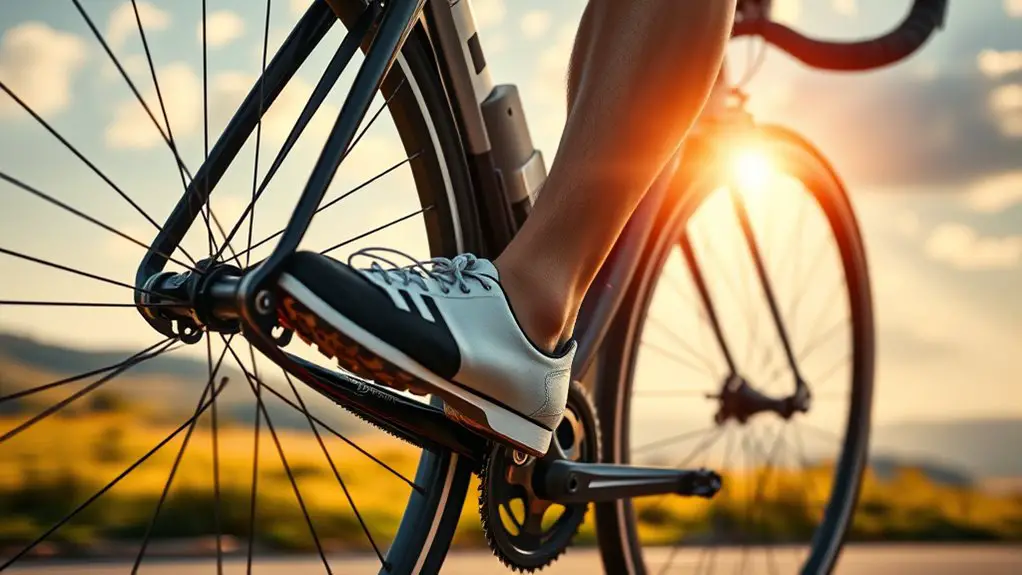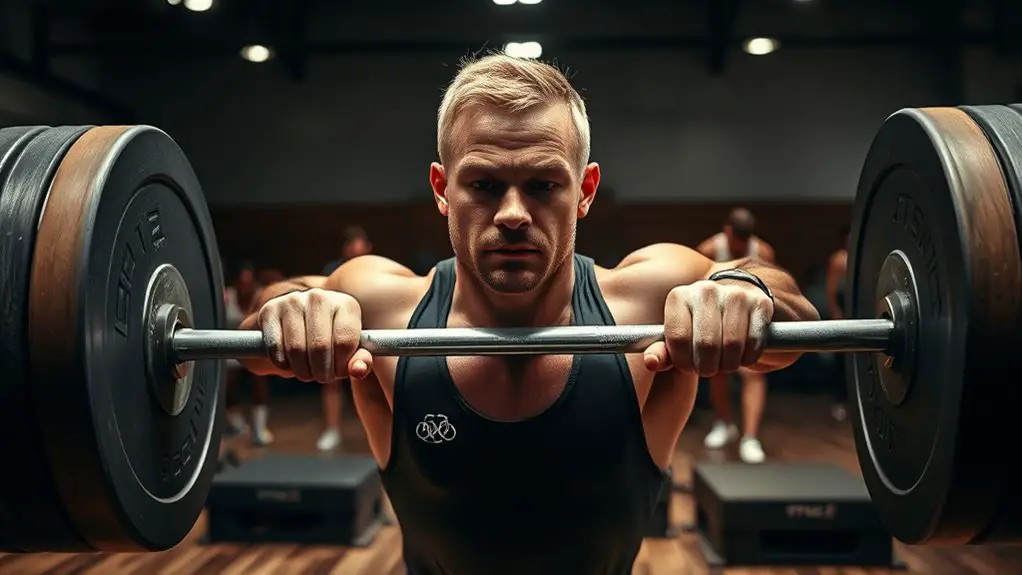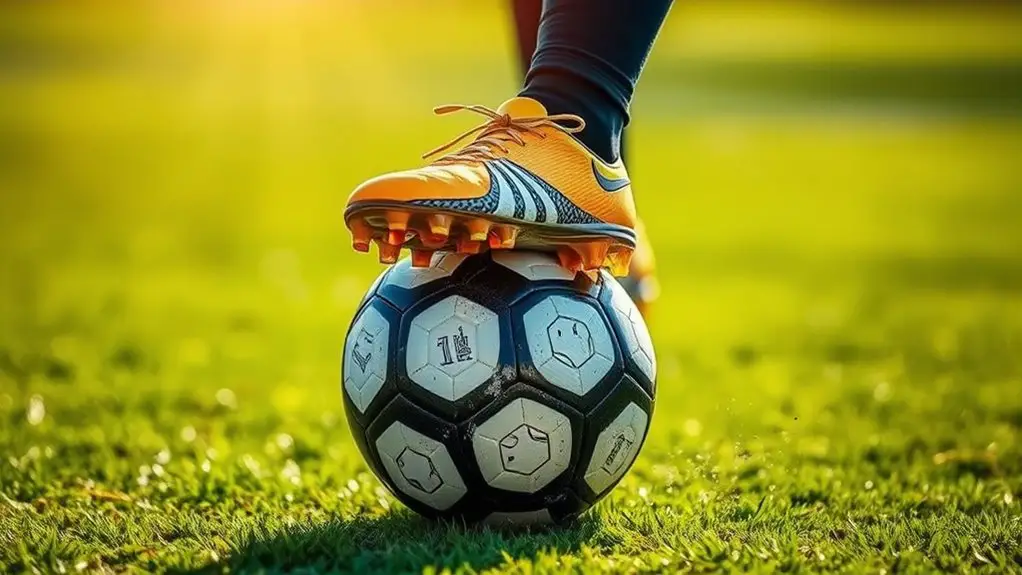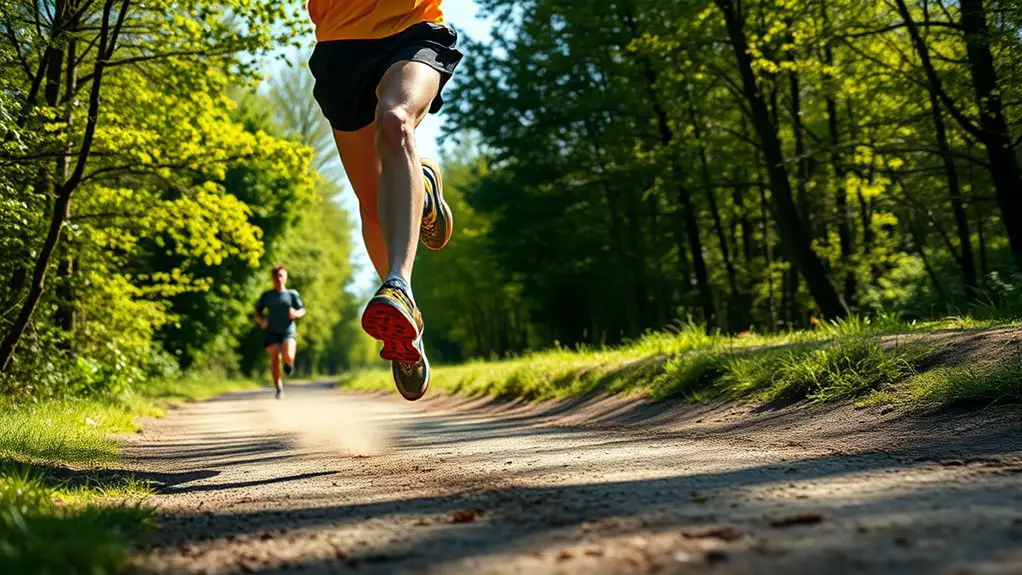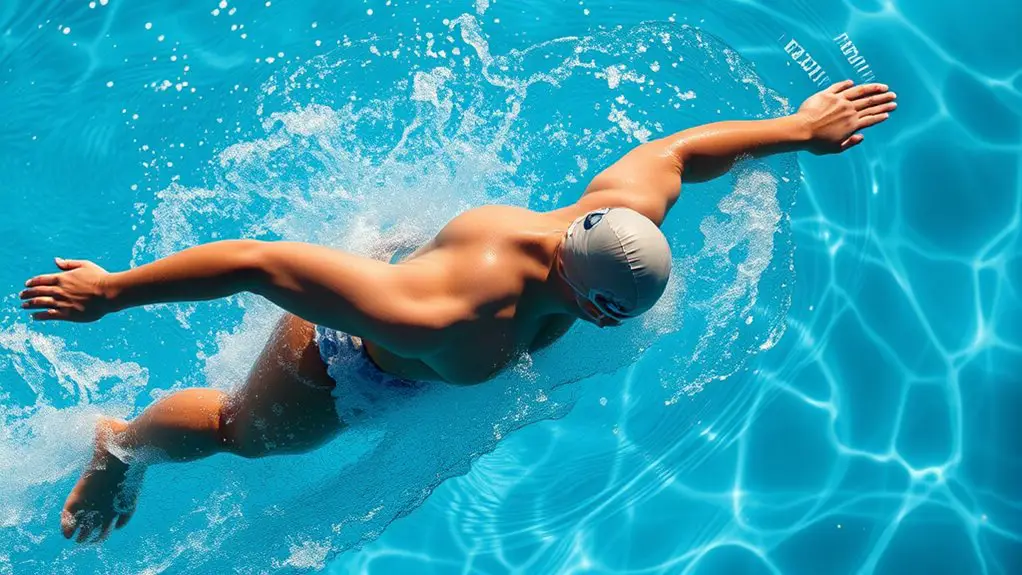To achieve an efficient pedal stroke, focus on mastering the four phases: downstroke, bottom dead center, upstroke, and top dead center. Engage your quadriceps for power during the downstroke and use your hamstrings in the upstroke to maintain a smooth motion. Proper body positioning and core engagement are essential for effective power transfer and avoiding fatigue. Correcting common mistakes can enhance performance considerably. There's much more to learn about optimizing your pedaling technique for better results.
Understanding the Pedal Stroke Cycle
When you think about cycling, understanding the pedal stroke cycle is vital for maximizing efficiency and power output. The pedal stroke involves a series of stroke phases that can make or break your ride. By breaking down your pedal stroke into these phases—downstroke, bottom dead center, upstroke, and top dead center—you can enhance your technique and release your freedom on the road.
During the downstroke, you push down with power, engaging your quads. As you reach the bottom dead center, shifting smoothly into the upstroke is essential; this is where many cyclists lose momentum. Focus on scraping your foot back, engaging those hamstrings. Finally, during the top dead center, prepare for the next downstroke. By mastering these stroke phases, you'll find a rhythm that feels natural, allowing you to ride longer and enjoy the thrill of the open road. Embrace the freedom cycling offers! Additionally, incorporating high-intensity interval training into your routine can further improve your overall cycling performance and endurance.
The Role of Muscle Groups in Pedaling
Mastering the pedal stroke cycle naturally leads to understanding the muscle groups involved in pedaling. When you pedal, it's not just your legs doing the work; it's a symphony of muscle coordination that brings freedom to your ride. The quadriceps generate power during the downstroke, while the hamstrings and glutes assist during the upstroke, creating a seamless flow. Your calves stabilize and help propel you forward, ensuring energy efficiency throughout the stroke.
Understanding how these muscle groups interact allows you to optimize your performance. By focusing on proper technique, you can improve muscle coordination, leading to smoother shifts and less fatigue. This efficient use of energy not only enhances your endurance but also makes every ride more enjoyable. Additionally, incorporating essential exercises for building muscular endurance into your training can further elevate your cycling performance. So, pay attention to how you engage these muscles; it's your key to releasing a more liberated cycling experience.
Importance of Body Positioning
Body positioning plays an essential role in optimizing your pedal stroke. When you're out there riding, the way you align your body can make a significant difference in performance and comfort. Getting it right isn't just about aesthetics; it's about functionality, too. Here are four key elements to take into account:
Body positioning is crucial for an efficient pedal stroke, enhancing both performance and comfort on your ride.
- Proper Body Alignment: Keep your spine neutral and your shoulders relaxed to guarantee efficient movement.
- Core Stability: Engage your core to maintain balance and control, which reduces fatigue over time.
- Knee Position: Your knees should track in line with your feet for a smoother stroke and to prevent injury.
- Foot Placement: Position your feet correctly on the pedals to maximize power transfer and efficiency.
Embrace your freedom on the bike by paying attention to these details. A well-aligned body and stable core can elevate your riding experience to new heights.
The Mechanics of Power Transfer
Optimizing your body positioning sets the stage for effective power transfer during your pedal stroke. When you align your body correctly, you're not just sitting on your bike; you're maximizing power generation. Your legs become engines that convert energy from your muscles into forward motion.
Think about how energy transfer works. As you push down on the pedals, the force travels through the crank, chain, and ultimately to the rear wheel. If your body's positioned poorly, you'll lose valuable energy, and that freedom you crave on the open road will slip away.
Engaging your core and maintaining a neutral spine helps stabilize your body, ensuring that every ounce of energy you generate is efficiently transferred. Proper hydration is essential for optimal performance, so make sure to drink enough fluids before and during your rides. Focus on maintaining a smooth, fluid motion throughout your pedal stroke, and you'll discover that the road feels a lot more inviting. With proper mechanics, you'll reveal the potential for greater speed and endurance.
Enhancing Cadence for Efficiency
While it's easy to focus solely on power output, enhancing your cadence can greatly improve your overall efficiency on the bike. By fine-tuning your cadence, you can experience greater freedom during your rides. Here are some tips for cadence optimization and rhythm adjustments:
- Find Your Sweet Spot: Experiment with different cadences to discover what feels most natural and efficient for you.
- Focus on Smooth Shifts: Work on maintaining a consistent pedal stroke, avoiding sudden changes in speed.
- Incorporate Intervals: Use interval training to build your ability to sustain higher cadences over longer periods.
- Monitor Your Metrics: Keep an eye on your cadence with a cycling computer or app to track improvements and make adjustments.
The Impact of Gear Selection
Choosing the right gear can greatly affect your pedal stroke efficiency and overall performance. When you pick a gear that matches your terrain and riding style, you're able to optimize your power output. Gear ratios play a vital role in this equation; they determine how hard you pedal versus how fast you go.
If you're climbing a steep hill, shifting to a lower gear can help you maintain a smooth cadence without burning out. Conversely, when cruising on flat roads, a higher gear lets you capitalize on your speed while still enjoying a relaxed pedal stroke.
Finding that sweet spot allows you to harness your energy effectively. Remember, it's all about the balance—choosing a gear that gives you freedom to push harder when needed while also conserving energy for the long haul. Embrace the ride by experimenting with different gear selections to discover what feels best for you!
Common Mistakes to Avoid
When you're cycling, it's easy to make mistakes that can affect your performance. Improper foot position and applying too much force can lead to inefficiencies and even injuries. Let's take a closer look at these common pitfalls and how to avoid them.
Improper Foot Position
Improper foot position can greatly affect your cycling efficiency and comfort, so it's crucial to pay attention to how your feet interact with the pedals. When your foot alignment's off, it can lead to unnecessary strain and decreased power. Here are some common mistakes to avoid:
- Misaligned Feet: Confirm your feet are parallel to the pedal stroke for ideal power transfer.
- Incorrect Cleat Position: Adjust your cleats for proper foot alignment; this impacts pedal pressure considerably.
- Too Much Weight on Heels: Keep your weight centered over the pedals to maintain balance and control.
- Tension in Ankles: Relax your ankles to allow for a smoother pedal stroke and better energy efficiency.
Focus on these points, and you'll enjoy a more liberated ride!
Excessive Force Application
Applying excessive force during your pedal stroke can lead to inefficiencies and fatigue, undermining your overall performance. When you push too hard, you disrupt the natural force distribution across the pedal, causing wasted energy and increased strain. Instead of focusing solely on power, aim for a smooth and consistent application of pedal torque. This way, you'll engage your muscles effectively without overexerting yourself. Remember, balance is key; a fluid stroke enhances both speed and endurance. By avoiding the urge to crank out excessive force, you'll find a rhythm that feels liberating and efficient. Embrace the art of controlled power, and you'll reveal your full cycling potential while enjoying every ride.
Techniques for Improving Pedal Stroke
Although many cyclists focus on speed and endurance, refining your pedal stroke can greatly enhance overall performance. By improving your technique, you'll not only ride more efficiently but also enjoy the freedom that comes with a smoother ride. Here are some techniques to take into account:
- Technique Analysis: Record your pedal stroke and analyze it. Look for areas of improvement, like dead spots or uneven power distribution.
- Focus on Cadence: Aim for a consistent cadence. This helps maintain a smooth pedal stroke and reduces fatigue.
- Engage Your Core: A strong core stabilizes your body while pedaling, allowing for better power transfer through your legs.
- Practice the Circle Pedal Stroke: Envision a circular motion, engaging all parts of your pedal stroke. This technique reduces wasted energy and increases efficiency.
Additionally, integrating mobility training into your routine can further enhance your pedal stroke by improving your overall range of motion. Embrace these techniques and watch your cycling experience transform!
Tools and Exercises for Refinement
To refine your pedal stroke, you'll want to focus on essential training tools and key drills that boost efficiency. Analyzing your technique can also help pinpoint areas for improvement. Let's explore how these elements can enhance your cycling performance.
Essential Training Tools
When it comes to refining your pedal stroke, having the right training tools can make all the difference. To enhance your pedal efficiency and overall performance, consider these essentials:
- Power Meters: Track your output and adjust your training intensity.
- Cadence Sensors: Monitor your cadence for ideal rhythm during endurance workouts and interval training.
- Bike Fit: Verify your bike fits you properly to enhance comfort and efficiency.
- Strength Training Tools: Incorporate weights and resistance bands to build the muscles needed for powerful strokes.
Don't forget to integrate effective recovery techniques into your routine. With these tools, you'll not only refine your pedal stroke but also embrace the freedom to ride with more power and endurance.
Key Drills for Efficiency
Mastering your pedal stroke requires targeted drills that focus on efficiency and technique. To enhance your performance, incorporate different drill variations that challenge your muscles and improve your pedal efficiency metrics. Here are a few key drills to contemplate:
| Drill Variation | Purpose |
|---|---|
| One-Legged Pedaling | Builds strength and balance |
| High Cadence Intervals | Boosts speed and efficiency |
| Resistance Sprints | Enhances power output |
Analyzing Your Technique
How can you guarantee your pedal stroke is as effective as possible? It starts with proper technique analysis and stroke evaluation. By refining your technique, you'll find freedom in your cycling experience. Here are four tools and exercises to enhance your pedal stroke:
- Video Analysis: Record your rides and assess your technique in real-time.
- Power Meters: Measure your output to identify areas for improvement.
- Cadence Drills: Practice maintaining a consistent cadence to optimize energy use.
- One-Legged Pedal Drills: Isolate each leg to improve strength and balance in your stroke.
Incorporating these methods will help you discover the most efficient pedal stroke, leading to a more enjoyable ride.
Frequently Asked Questions
How Does Bike Fit Influence Pedal Stroke Efficiency?
Imagine riding a steed through the wild west; your bike fit's just as essential for freedom on two wheels. Saddle height, cleat position, and frame geometry all play a role in your pedal stroke efficiency. If your leg extension isn't ideal, you can tire out quickly. Adjusting these elements guarantees you can ride longer and with less fatigue, giving you the freedom to explore the open road without limits.
What Role Does Nutrition Play in Cycling Performance?
Nutrition's essential for your cycling performance, and getting it right can make all the difference. Focus on carbohydrate timing; fueling up before and during rides guarantees you've got the energy to keep going. Don't forget hydration strategies, too! Staying properly hydrated helps maintain your stamina and prevents fatigue. When you balance your nutrition, you'll feel that freedom to push harder and enjoy every ride, knowing you've got the fuel to perform at your best.
Are There Specific Shoes for Better Pedal Stroke?
Absolutely, there are specific shoes designed to enhance your pedal stroke. Look for options with adjustable cleat positioning, as this can greatly affect your efficiency and comfort. You'll also want shoes with the right stiffness; a stiffer sole helps transfer more power with each push. Finding that perfect combination lets you ride freely, allowing you to enjoy the open road without worrying about discomfort or inefficiency in your pedal stroke.
How Can Mental Focus Enhance Pedal Stroke Efficiency?
To enhance your pedal stroke efficiency, mental focus is key. You can use visualization techniques to imagine each stroke flowing smoothly, which helps your body sync with your mind. Mindfulness practices, like concentrating on your breath, can keep distractions at bay, allowing you to fully engage in the moment. This clarity not only improves your technique but also gives you a sense of freedom as you ride, making each pedal stroke feel more powerful and intentional.
What Is the Impact of Fatigue on Pedal Stroke?
Imagine pedaling like a superhero, but suddenly, fatigue crashes your party! When you're worn out, fatigue effects can wreak havoc on your pedal stroke, reducing power and efficiency. It's like trying to sprint in molasses! Managing your energy becomes essential to maintain that glorious freedom on your ride. Focus on pacing and recovery to keep fatigue at bay, ensuring every stroke propels you forward instead of dragging you down.
